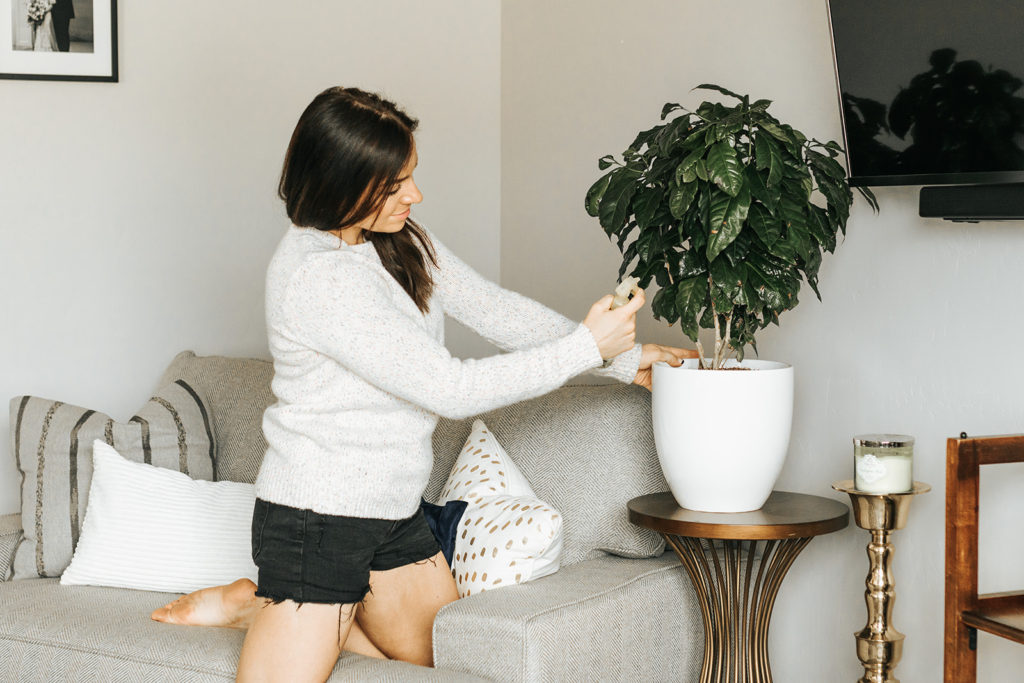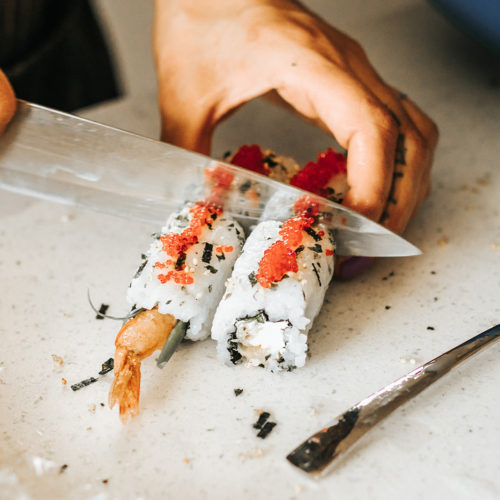This post may contain affiliate links. This means if you make a purchase through one of these links I may or may not receive a small commission at no additional cost to you.
My husband thinks my obsession with houseplants has gone too far, but little does he know I’m just getting started! Most of my plants have to be grown indoors, because I live in Utah which is one of the least friendly plant states. I’m not native to Utah, but it’s definitely become home in recent years. The thing I hate most about my adopted state? The weather.
Luckily, I’ve figured out the art of growing citrus trees indoors, and I’m so excited to share it with y’all.
When I first decided to purchase my lemon tree, I was told by many people it would likely die. “They’re just so hard to keep alive,” was what I heard over and over. But of course, I ignored everyone and bought one anyway.
Growing citrus trees indoors is not like growing any old house plant. They have very specific needs, and they’re always “in season,” if you will. Meyer Lemon Trees are the most common and hardy citrus trees to grow indoors, but there are many other versions. The guidelines for growing lemon trees are pretty much the same for growing any other form of citrus tree.
If I’ve learned anything in my years as a plant mom, it’s that where and when you buy your plants matters just as much as how you take care of them. I took a gamble on Fast Growing Trees, because they have one-year warranties included in the price of the tree. Additionally, I chose to purchase an older tree, because I know mature plants are more likely to survive–this is also why they’re more expensive!
Because I’m a sucker for free shipping…I also bought a coffee bean plant. More on that later…
I learned most of what I know about growing citrus trees on the Fast Growing Trees website–love love LOVE how thorough and helpful they are–but I also did plenty of other research. Combining that with my past year of experience keeping this lemon baby alive, I’m happy to share with you what I’ve learned.

Here are the 5 Most Important things to Know about Growing Citrus Trees Indoors:
1. Full Sunlight is Non-Negotiable
Your citrus tree needs 12 hours of direct sunlight daily. It simply won’t do well otherwise. I also turn my tree once a week to change the direction at which the sunlight hits the tree. (I actually do this with all my house plants, it ensures they grow evenly and don’t “reach” for light) Your citrus tree can also be outside during the summer months of colder climates, but make sure to “harden” it first. Put it outside just a few hours each day, slowly increasing the time it spends outside. This allows the tree to adjust to being outside. If you don’t do this, it might die of shock.
2. Acidic Soil is Key
I purchased the Root Rocket Fertilizer and soil offered by Fast Growing Trees. As I was expecting a finicky plant, I wanted to ensure I did everything right the first time. In addition to using their premium potting ingredients, I added 1 Cup of freshly ground coffee beans, unbrewed, for extra acidity.
3. Do NOT Over-Water!
Over-watering is the number one mistake I see in new plant parents. You can absolutely drown your plants, or create root rot. The soil should be moist to the touch for the first couple of weeks your plant gets used to your environment, then it should only feel moist a couple inches below the surface (source).
I water my citrus about every two days or so. To keep in moisture, some people top their soil with rocks, moss, or decorative sand. However, I haven’t done that and my soil seems happy.
4. Humidity is Happiness
Remember citrus trees prefer tropical climates. If you don’t live in one, you can simulate one super easily. Simply spritz your tree with water once a day, or keep a humidifier in the room. Easy as that lemon pie you’re going to make when your tree bears fruit.
5. Your Pot Should Grow with Your Tree
If a plant becomes too root-bound–aka crowded–it won’t be able to absorb nutrients and as a result die. Consistently keep your pot 2 sizes bigger than your citrus tree, or plant it in a much bigger pot to begin with. I prefer to have my plants in pots relative to size, so I started out with a cute green pot I found at the AT HOME store.

These 5 tips will make growing citrus trees indoors a breeze. Especially if you purchase from Fast Growing Trees, because they have a one-year warranty. This brings me back to my coffee bean tree. I hate paying for shipping, so I always purchase the free shipping minimum. You don’t have to tell me this is a marketing ploy, I already know. Anyway. I decided it might be fun to grow, harvest, and roast my own coffee beans. So, like you do, I got a coffee bean tree!
Both trees were delivered in January, and I’m pretty certain the coffee tree arrived dead. I gave it about four weeks of sunlight, water, and tender love to be sure, because shipping can make trees go dormant, and look dead. After a month, I sent a picture to Fast Growing Trees and they immediately agreed to a refund, or to send a new tree in April. I appreciated having a choice, but I also appreciated their honesty about the difficulty of shipping a tropical tree during winter. Sure enough, in April, I received this beautiful tree at my doorstep.

Though it’s not citrus, this tree is absolutely tropical. This means the process is almost exactly the same as growing citrus trees.
All this talk about lemons makes me hungry for my favorite lemon recipe. I have yet to reap the fruiting benefits of my tree, because the tree I purchased is two years away from a harvest. Fast Growing Trees does sell already fruiting trees, but they cost more than I wanted to spend. I also wanted the bragging rights of saying I raised a citrus tree to fruit in the State of Utah!
Have you ever grown citrus? Indoors or outdoors? If so, I’d love to hear about it in the comments below.






